Organic Food Statistics – By Market Value, Demographics, Products and The Time of Eating
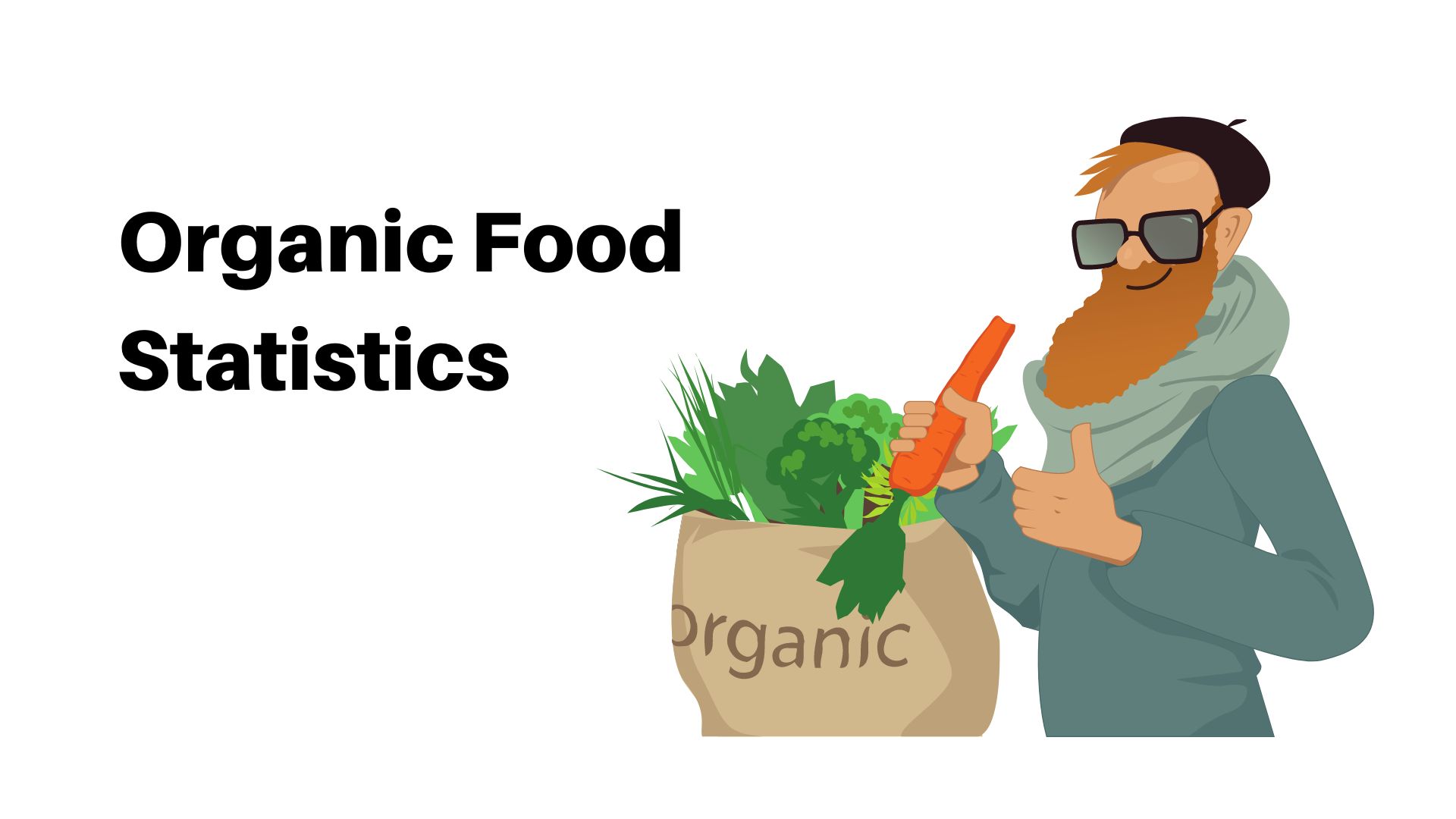
Page Contents
- Introduction
- Editor’s Choice
- What Is Organic Food?
- Benefits of Organic Food
- Organic Food Facts
- General Organic Food Statistics
- Who Purchases Organic Food?
- Organic Food Statistics By Market Value
- Organic Food Statistics By Demographics
- Organic Food Statistics By Method of Purchase
- Organic Food Statistics By Leading Organic Brands
- How Many People In The US Eat Organic Food?
- Organic Food Statistics By Products
- Organic Food Statistics By The Time Of Eating
- When Do Consumers Usually Purchase Organic Products?
- Conclusion
Introduction
Organic Food Statistics: Nowadays globally, the habits of eating food have been changing on a drastic level. There used to be a time when people used to eat only healthy food, which then shifted to a mixture of healthy and junk food. Today, the majority of people are behind in junk food, but simultaneously, people with sustainable thoughts are demanding more and more organically grown products. These products save the environment as well as are good for health.
These Organic Food Statistics have been written with well-researched material focusing on the American region with recent and interesting insights.
Editor’s Choice
- As stated by Organic Food Statistics, it has been projected that the organic soft drinks industry will reach more than $10 billion by 2030.
- The global organic beverage market is expected to grow by 12.3% by 2025 around the globe reaching $12.8 billion.
- According to Organic Food Statistics, USDA will increase the funding to the organic food industry by $50 million as of 2023.
- In the United States of America, 55% of consumers purchase organic food in supermarkets.
- As of today, organic fruits and vegetables are the most popular type of food in the United States of America.
- Millennials with children are more likely to spend on organic food.
- 76% of adults purchase organic food for health reasons while the remaining 33% purchase it for environmental purposes and 22% buy it for their convenience.
- 62% of Americans said they are interested to purchase organic food if it were more affordable.
- People with higher salary brackets are more likely to purchase organic food for consumption.
- As of 2022, in the United States of America, organic food is available in more than 20,000 natural food stores.
What Is Organic Food?
Biological Food or Ecological Food often referred to as Organic Food, includes foods and drinks that are produced by complying with organic farming standards. These standards include promoting ecological balance, cycling resources, and protecting biodiversity. Companies that manufacture organic food have limited usage of pesticides as well as fertilizers. Moreover, these types of foods are not processed using industrial solvents, irradiation, or any synthetic food additives. The major type of organic foods are grains, vegetables, fruits, and dairy products such as meat, cheese, and milk.
Benefits of Organic Food
- Low level of toxic metals consumption.
- Decreased chances of food poison.
- Organic milk and meat are 60% richer in omega-3 fatty acids, vitamins, and antioxidants.
- Organically grown food is produced along with the standard therefore consumption of such types of food is fresh.
- Decreased rate of interferences to natural resources.
- These types of foods are not genetically changed.
- Increases strength of the immune system.
- Improved health condition as well as a healthy heart.
Organic Food Facts
- In 2015, Sikkim was named the world’s first 100% organic state.
- Year by year, organic food will become costly.
- Organic Foods tend to have more antioxidants than other types of foods resulting in 20% to 40%.
- Globally, considering all the markets and various types of consumers, it is comparatively difficult to recognize the consumer of organic food.
- Organic food contains 48% less cadmium concentration.
General Organic Food Statistics
- According to Organic Food Statistics, USDA will increase the funding to the organic food industry by $50 million as of 2023.
- Around 83% of Americans have tried organic meat at least once in their lifetime.
- Of organic food consumers in North America resulting in 15.56% buy organic food.
- In the United States of America, there are at least 3 organic food stores compared to 4 conventional stores.
- North America has the largest retail share in organic products.
- In the United States of America, 30% of households consume organic food.
- Organic food generates on average 6% of the share in all food sales in the United States of America.
- As stated by Organic Food Statistics, it has been projected that the organic soft drinks industry will reach more than $10 billion by 2030.
- The global organic beverage market is expected to grow by 12.3% by 2025 around the globe reaching $12.8 billion.
- According to a study of Organic Food statistics, demand for similar products surpasses the supply considering the year-to-year growth.
- Moreover, with increasing demand, the Organic Farming industry has more jobs available than conventional farming.
- As a compulsory procedure, products sold in the United States of America under organic foods have to be certified by the USDA.
- As per the Organic Food Statistics of 2021, India ranked top for having the highest number of organic food producers.
- As of 2021, the sale of organic food generated around 57.5 billion in the United States of America, during this period, meat and yogurt were the most frequently purchased products.
- Moreover, Organic Packaged Food has the highest and increasing demand with an expected consumption value of more than $25 billion.
- Switzerland and Denmark have the highest rate of per capita organic food consumption as of 2021.
- Furthermore, the total value of organic food sales globally generated $132.74 billion.
- The recorded growth of organic food sales in the United States of America as of 2021 is only 2%.
- As of 2022, it was expected that the value of organic packaged food consumption in the United States of America would be more than $21 billion.
- A popular way to order organic foods from top brands in the United States of America is from Amazon.com.
- By the year 2026, the global organic food market is expected to grow at a CAGR of 14% reaching $437.36 billion.
- 62% of Americans said they are interested to purchase organic food if it were more affordable.
- 83% of the citizens in the United States of America are thinking of buying organic food.
- As of 2022, in the United States of America, organic food is available in more than 20,000 natural food stores.
Who Purchases Organic Food?
- 12% of households purchase organic food all of the time.
- People who have a taste in music are more likely to buy organic food.
- Sports fans tend to purchase 49% times more organic food than non-sports fans resulting in 49%.
- 53% of pet owners are more likely to buy organic food items than non-pet owners resulting in 37%.
Organic Food Statistics By Market Value
- As of 2022, the value of organic packaged food consumption in the United States of America is $21.39 billion.
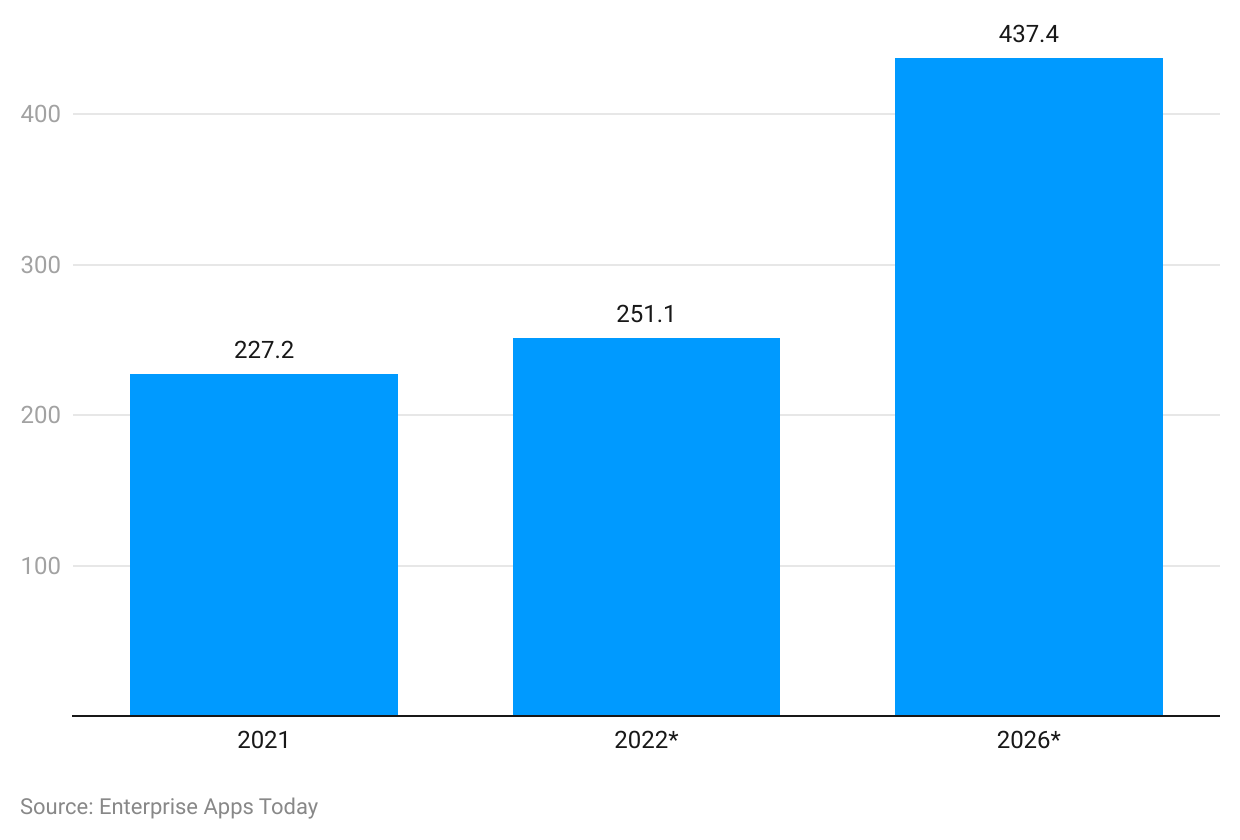
(Reference: Statista.com)
- As of 2021, Organic Food Statistics state the global organic food and beverage market value was $227.2 billion which rose to $251.1 billion in 2022.
- As of 2026, the expected market value for the global organic food and beverages market is $437.4 billion.
Organic Food Statistics By Demographics
- The highest number of organic food consumers live in metropolitan areas in the United States of America.
- People with higher salary brackets are more likely to purchase organic food for consumption.
- Organic food consumers below the age of 40 are leading consumers of meat, fruits, and vegetables.
- Millennial parents are more likely to follow a vegan or vegetarian lifestyle.
- Millennials with children are more likely to spend on organic food.
- 76% of adults purchase organic food for health reasons while the remaining 33% purchase it for environmental purposes and 22% buy it for their convenience.
- As of December 2021, 75% of the female population and 25% of the male population has seen buying organic food products.
- 20% of the Millennials and Gen Z people buy organic food all the time, while only 8% of Gen X and 7% of Baby boomers do the same.
By The Number Of Children
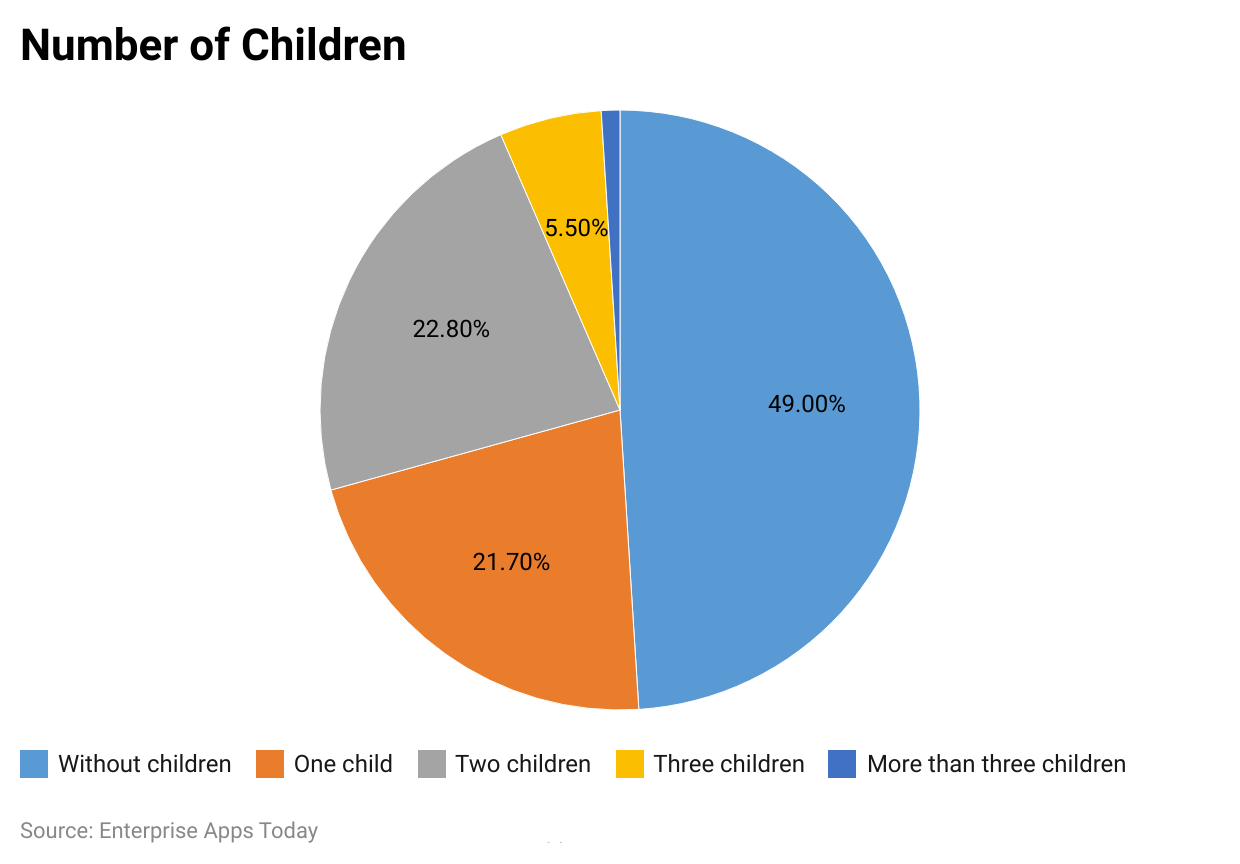
(Reference: researchgate.net)
- 49% of households without any children purchase organic food, while 22.80% of the household have two children with organic purchase habits.
- Moreover, there are 21.70% of households with one child, with organic food item purchasing habits.
- On the other hand, a household with 5.50% and 1% with three and more three children also purchase a similar type of food.
Organic Food Statistics By Method of Purchase
- In the United States of America, 55% of consumers purchase organic food in supermarkets.
- Whereas 36% of Americans purchase organic food from mass merchandisers.
- On the other hand, 13% of American consumers purchase organic food via online methods.
Organic Food Statistics By Leading Organic Brands
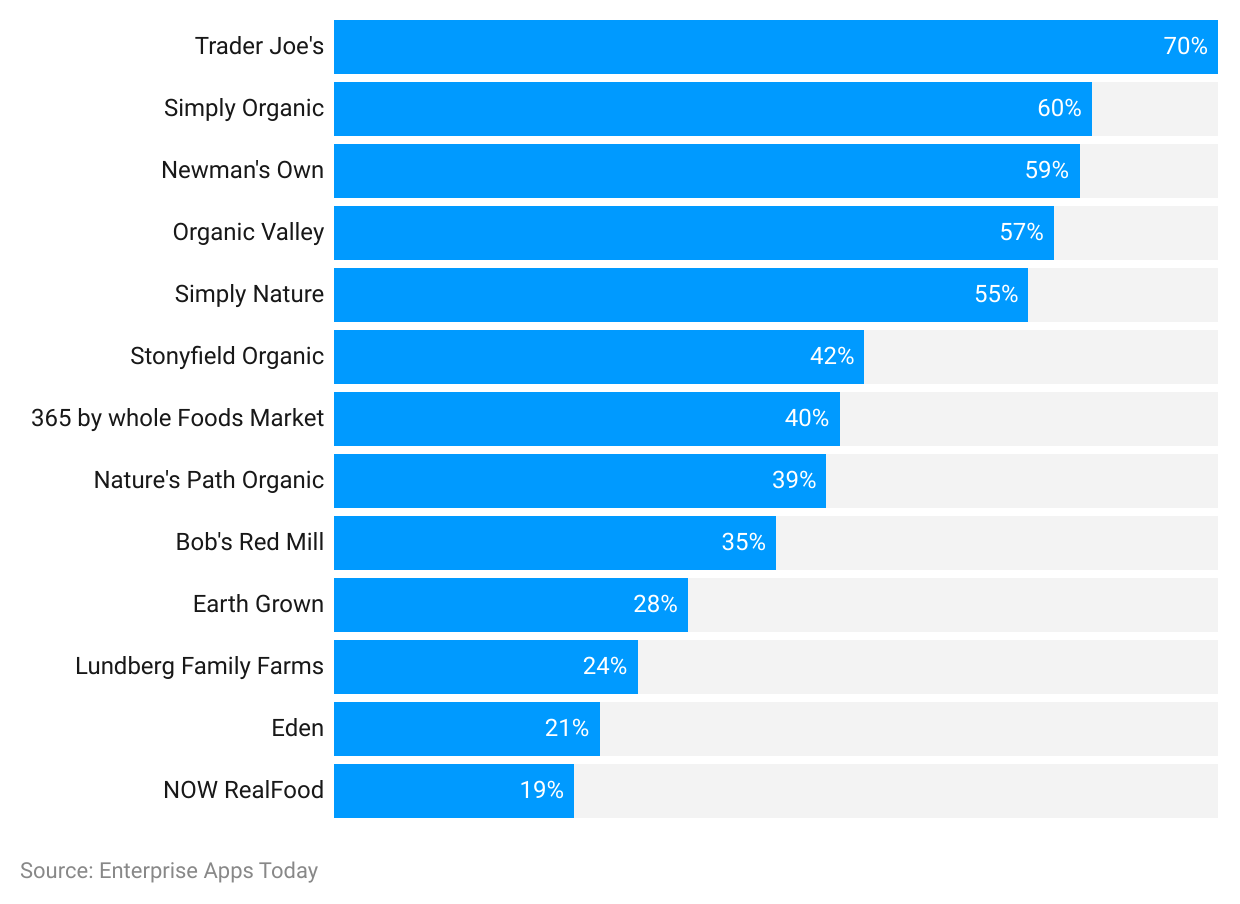
(Reference: Statista.com)
- The top 3 leading organic brands in the United States of America in 2022 were Trader Joe’s, Simply Organic, and Newman’s Own resulting in (70%), (60%) and (59%) respectively.
- Other top organic companies with the highest level of brand awareness in the United States of America are Organic Valley (57%), Simply Nature (55%), Stonyfield Organic (42%), 365 by Whole Foods Market (40%), Nature’s Path Organic (39%), Bob’s Red Mill (35%), Earth Grown (28%), Lundberg Family Farms (24%), Eden (21%), NOW Real Food (19), and Frontier Co-Op (19%).
How Many People In The US Eat Organic Food?
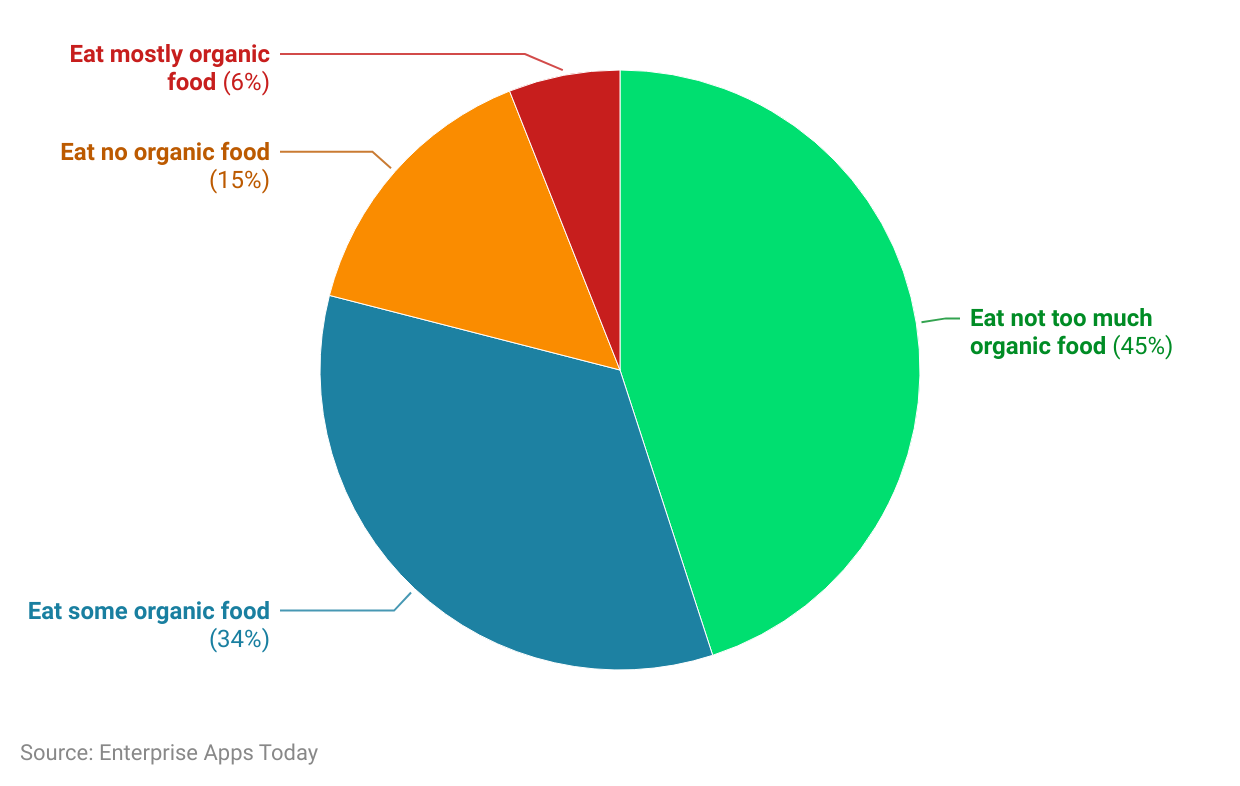
(Reference: theconsciousinsider.com)
- In the United States of America, 45% of the consumer eat organic food with have a limited eating lifestyle.
- Moreover, 34% of Americans eat some quantity of organic food.
- 6% of Americans stated that they mostly eat organic food, on the other hand, there are 15% of the population in America does not eat this type of food.
Organic Food Statistics By Products
- As of today, organic fruits and vegetables are the most popular type of food in the United States of America.
- Organic crops need 50% less energy as compared to conventional crops for production.
- In the year 2022, the sales of organic potatoes increased by 10.7% in the United States of America.
- As of 2021, 15% of the total market was contributed by organic fruits and vegetables with a revenue of $21 billion.
- The sales for organic dairy and eggs stood at a stagnant level in the year 2021.
- The overall sales for organic bread and grains were lowered in the year 2021 but generated around $6.2 billion.
- Moreover, as of 2021, Organic Food Statistics state that, organic coffee ranked top in the beverage category for showing 5% of growth and generating $2 billion in annual sales.
- Organic meat and milk have balanced fatty acids.
- As of 2022, in the United States of America, organic berries generated $1 million in total sales by ranking top in the list of top-selling organic fresh produce, other organic products that ranked in the list are carrots, apples, spinach, and tomatoes.
- As of 2022, considering the best-performing organic commodities in terms of volume and year-over-year growth, grapes stood at the top with 6.9% followed by herbs and spices (6.5%), and cucumbers (2.7%).
- 48% of organic food consumers state that they are ready to purchase any other kind of organic food.
- 17% of the similar category consumers state that they would never purchase any alcoholic beverages or canned fruit or vegetables in organic versions.
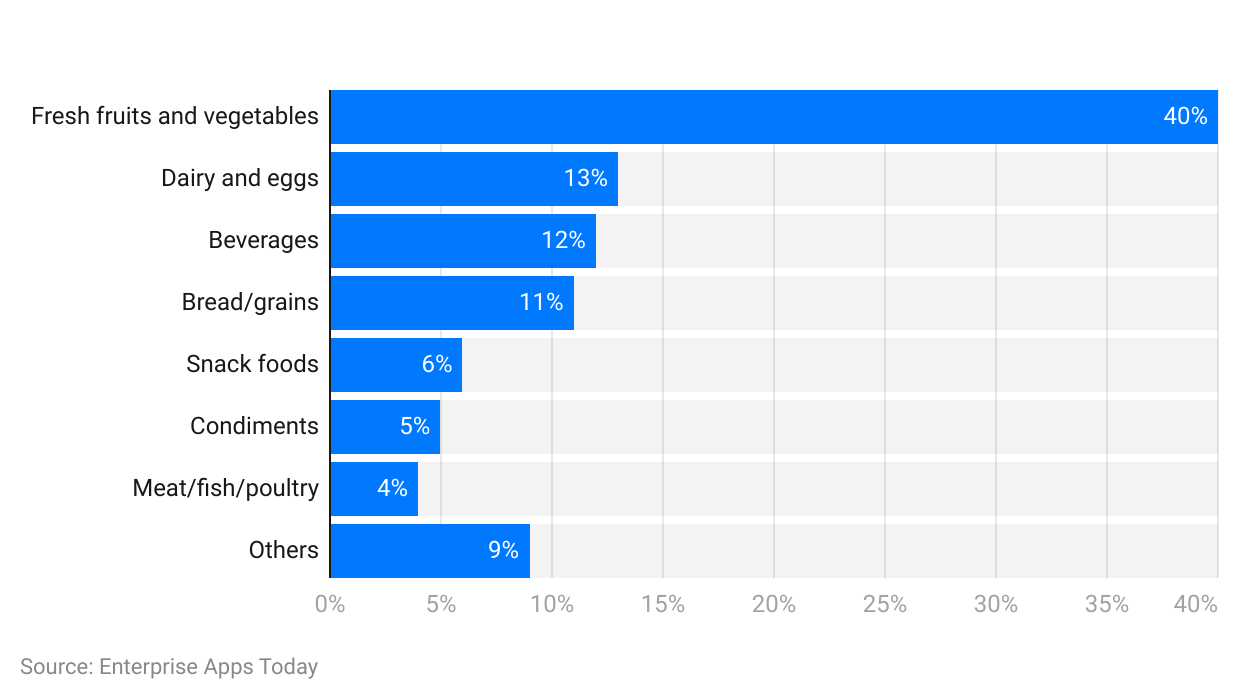
(Reference: theconsciousinsider.com)
- According to the Organic Food Statistics of 2022, in the United States of America, the highest demand is for organic fresh fruits and vegetables resulting in 40%.
- Whereas the other top two organic products are dairy and eggs (13%) and beverages (12%).
- Moreover, other trending organic products in the United States of America are bread/Grains (11%), Snack foods (6%), Condiments (5%), Meat/Fish/Poultry (4%), and other types of products (9%).
Organic Food Statistics By The Time Of Eating
- 67% of the consumers eat organic food during dinner time.
- On the other hand, 62% of people love to eat such types of food items during lunchtime.
- There are 56% of people prefer to eat organic at breakfast.
- While 35% and 27% of consumers eat it during afternoon snacks and morning snacks respectively.
When Do Consumers Usually Purchase Organic Products?
- 28% of the consumers never purchased such type of products.
- As of 2022, 27.9% of the people stated purchasing organic food once a month while 25% of the consumers purchased it once a week.
- There were 13.5% of people who purchased organic food 2 to 3 times a week and 5.4% of the consumers went for purchase daily.
Conclusion
These Organic Food Statistics prove that despite these products being costly, the demand is continuously rising. Moreover, unlike in the old days, people can order various types of products online. Moreover, it is convenient to order, and deliveries are made within 24 hours. Surprisingly, in the market, there’s a new trend where under the name of organic, people are eating organic junk food, and yet it is total junk. We can’t imagine how many variants are going to launch in the market in the coming years, but rather than eating junk and useless food organic food is always healthy and tasty!
Sources
FAQ.
Amy’s Kitchen, General Mills Inc, Cargill Inc, Danone, Dole Food Co, Everest and EDEKA Handelsgesellschaft Nord GmbH, Whole Foods Market Inc, and United Natural Foods Inc are some of the top players in the global organic food market.
You can purchase organic food items in specialty stores, convenience stores, supermarkets, or hypermarkets. Nowadays, these types of food items are also available in online stores such as Amazon.com.
As of 2021, the Fruit and vegetables segment influenced the global organic food and beverages market with a share of 35%.
Organic food can cost 20% to 100% more as compared to conventionally produced food items.

By conducting scientific research, I write about illness, health and healthcare. As a professional medical writer, my experience includes creating feature articles for newsletters and websites as well as research news stories for doctors and researchers. Reading has been an integral part of me since childhood - I'm fan of "Friends" and the "Harry Potter series". Before this career, I was employed by a French multinational company. However, my passion for reading led me to pursue writing professionally; my first Amazon-published short story entitled "The envelope that changed our lives" has recently been released. In my free moments, I enjoy long bike rides around town.